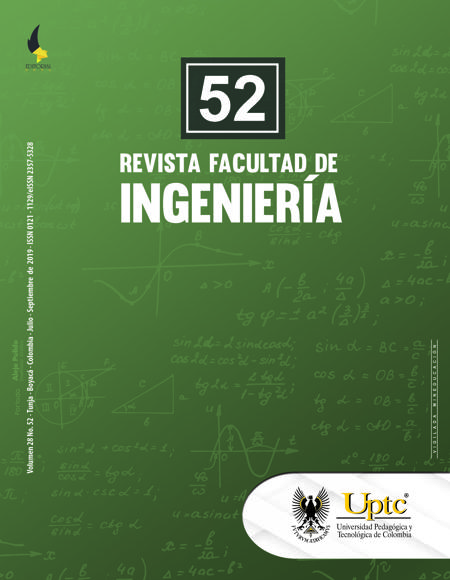The State of Energy Research in Colombia: A View from the Research Groups

Abstract
This article presents the state of research in Colombia on energy issues from the review, systematization and analysis of the results of the research groups. The information was obtained from the Scienti platform of Colciencias of a sample of research groups that claim to have lines of interest in energy. Three categories were considered for the analysis of the information: geographical location of the groups and their classification; research interests determined from the proposed lines of research; and scientific production of the groups. It was found that 75 % of the groups are in 4 of the 32 departments of the country and 90 % belong to higher education institutions. There is diversity in terms of research interests, with four main lines of action: energy and power, energy management, hydrocarbons and renewable energies. The scientific production is centered basically in scientific articles, books and development of projects, as for patents the results are scarce. In relation to ER, the scientific production began to emerge from 1999 and has experienced a linear growth. It is possible to identify that although there is established research on energy issues from higher education institutions and some companies in the energy sector, advances related to renewable energies are still incipient; there is a road ahead which is fertilized with the new regulations that have been given in the country.
Keywords
energy, renewable energies, research groups, scientific production
References
[1] The Intergovernmental Panel on Climate Change –IPCC-, Renewable Energy Sources and Climate Change Mitigation. Special Report of the Intergovernmental Panel on Climate Change, 2012. Available at: https://www.ipcc.ch/site/assets/uploads/2018/03/Title-1.pdf.
[2] Consejo Mundial de la Energía, Consejo Mundial de la Energía, 2017. Available at: https://www.worldenergy.org/wp-content/uploads/2014/04/WEC_16_page_document_21.3.14_ES_FINAL.pdf.
[3] Unidad de Relaciones Externas e Institucionales del Grupo Banco Mundial, Informe anual: Poner fin a la pobreza. Invertir para generar oportunidades, 2013. Available at: http://www.bancomundial.org/es/results/2013/04/13/climate-change-results-profile.
[4] C. García Arbeláez, X. Barrera, R. Gómez, and R. Suárez Castaño, El ABC de los compromisos de Colombia para la COP21. Colombia: WWF-Colombia, 2015.
[5] D. Jacobs, N. Marzolf, J. Paredes, W. Rickerson, H. Flynn, B. Becker, and P. Solano, “Analysis of Renewable Energy Incentives in the Latin America and Caribbean Region: The Feed-in Tariff Case,” Energy Policy, vol. 60, pp.601-610, Sep. 2013. https://doi.org/10.1016/j.enpol.2012.09.024.
[6] N. Nuttall, Informe anual. División de Comunicaciones e Información Pública del Programa de las Naciones Unidas para el Desarrollo Medioambiental, 2011.
[7] W. Cai, G. Santoso, S. Yeh, S. An, K. Cobb, M. Collins, F. Jin, J. Kug, M. Lengaigne, M. Mcphaden, K. TakahashI, A. Timmermann, G. VecchI, M. Watanabe, and L. Wu, “ENSO and Greenhouse Warming," Nature Publishing Group, vol. 5 (9), pp. 849-859, 2015. https://doi.org/10.1038/nclimate2743.
[8] Congreso de la República de Colombia, Ley 1715 de 2014, 2014. Available at: http://www.secretariasenado.gov.co/senado/basedoc/ley_1715_2014.html.
[9] Ministerio de Minas y Energía, Resolución 030 de 2018, 2018. Available at: http://apolo.creg.gov.co/Publicac.nsf/1c09d18d2d5ffb5b05256eee00709c02/83b41035c2c4474f05258243005a1191?OpenDocument.
[10] F. Romo, B. Guerrero, and A. Moya, “Análisis de la producción científica española en energías renovables, sostenibilidad y medio ambiente (Scopus, 2003-2009) en el contexto mundial,” Investigación Bibliotecológica, vol. 27 (60), pp 125-151, 2013. https://doi.org/10.1016/S0187-358X(13)72546-2.
[11] A. Endo, I. Tsurita, K. Burnett, and P. M. Orencio, “A Review of the Current State of Research on the Water, Energy, and Food Nexus,” Journal of Hydrology Regional Studies, vol. 11, pp. 20-30, Jun. 2017. https://doi.org/10.1016/j.ejrh.2015.11.010.
[12] A. Celaya Lozano, D. Luque Agraz, J. García Hernández, J. A. Amozurrutia de María y Campos, J. M. Preciado Rodríguez, J. Laborín Álvarez, and R. E. Cabanillas López, “Evaluación de la producción científica de sustentabilidad ambiental en un centro público de investigación (cpi) del Conacyt (1982-2012)”, Rev. la Educ. Super., vol. 46 (182), pp. 89-112, 2017. https://doi.org/10.1016/j.resu.2017.04.002.
[13] R. A. Palacios, Inventario documentado de represas en Colombia, Thesis, Universidad Militar, Bogotá D. C., 2013. Available at: https://repository.unimilitar.edu.co/bitstream/10654/11360/1/PalaciosSierraRicardoAndres2013.pdf.
[14] Departamento Administrativo de Ciencia Tecnología e innovación COLCIENCIAS, Modelo de medición grupos de investigación, desarrollo tecnológico o de innovación y de reconocimiento de investigadores del sistema nacional de ciencia, tecnología e innovación, 2015. Available at: http://www.colciencias.gov.co/sites/default/files/upload/noticias/mediciondegrupos-actene2015.pdf.
[15] Comisión de Regulación de Energía y Gas –CRE-, Quienes somos, 2018. Available at: http://www.creg.gov.co/index.php/creg/quienes-somos/historia.
[16] Ministerio de Minas y Energía, El futuro es de todos, 2011. Available at: https://www.minminas.gov.co/documents/10180/23400/05-ENERGIA2010-2011.pdf/770a198d-d4ee-4687-b74c-74592b403ae6.
[17] XM. Filial de ISA, Informe de operación del SIN y administración del mercado, 2014. Available at: http://informesanuales.xm.com.co/2014/SitePages/operacion/3-1-Demanda-de-energia-nacional.aspx.
[18] B. González-Pereira, V. P. Guerrero-Bote, and F. Moya-Anegón, “A New Approach to the Metric of Journals? Scientific Prestige: The SJR Indicator,” Journal of Informetrics, vol. 3, pp. 379-391, Jul. 2010. https://doi.org/10.1016/j.joi.2010.03.002.